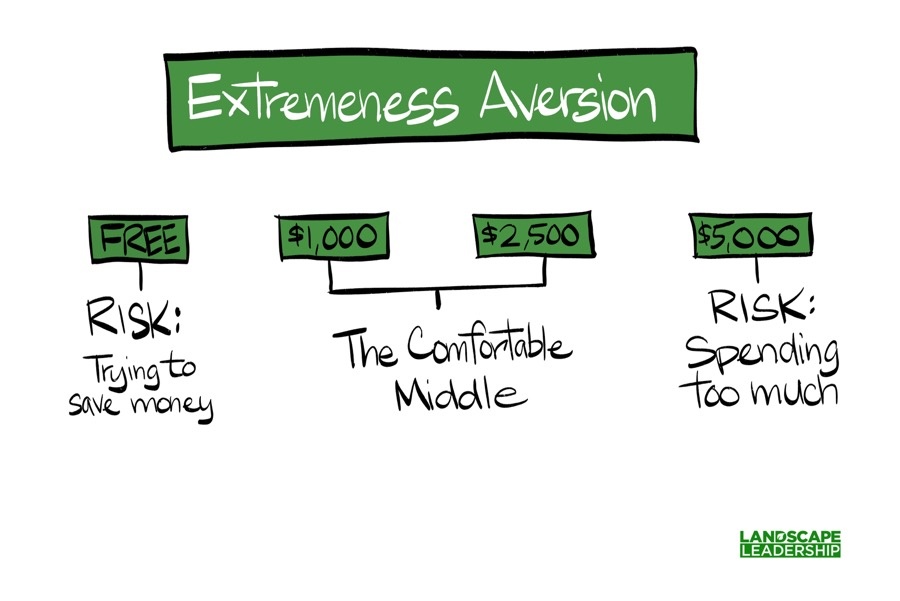Packaging and Pricing Lawn Care Services (The Psychology and Strategy)
 Author: Chris Heiler
Author: Chris Heiler
The way lawn care is sold online is a hot mess.
Yes, I'm referring to your website.
Trust me, I've reviewed hundreds of lawn care and landscaping company websites over the past 12 years, and, most significantly, how your programs and pricing are being presented to potential customers.
Like I said... hot mess.
Which means you're losing sales and leaving a boat load of money on the table.
The main problem, as I see it, is that you don't fully appreciate what you are selling.
"Choose between our 7-visit program... our 9-visit program..."
Rather than selling "visits" you should be selling a "transformation". Sure, you're charging for "treatments" but your customers are buying a "healthy lawn".
Big distinction.
Rarely do I see a logical packaging/pricing strategy based on actual consumer buying behavior. Instead, lawn care pricing strategy is typically based on the cost per visit (then sold that way).
"Get a quote for our 7-visit program starting at $462 per year..."
Your customers don't care what your costs are nor how many times you have to visit their home. They're buying a "healthy lawn".
Your prospects and customers deserve straightforward pricing based on how they want to buy, not based on how you want to sell.
Lawn care pricing strategy
I want to teach you a logical pricing strategy based on consumer psychology and buying behavior. You can implement this on your website tomorrow and immediately...
- Increase your conversion rate on your company website, which...
- Will increase your sales volume and recurring revenue, while at the same time...
- Increase profit per customer
You can use this pricing strategy for lawn care and any other recurring service such as landscape maintenance, seasonal color, holiday decor, plant health care, etc. If you offer landscape design and design/build services you can read my related pricing strategy for those project-based services here (part 1, part 2).
I know it can be a little uneasy doing things differently, but, remember, differentiation is where the profit is.
At Landscape Leadership we've been helping our clients tweak their lawn care programs and pricing and they've seen fantastic results. We've done the same internally and have had great success.
You can do this too.
Principles for bundling and pricing your lawn care services
Principle 1: Always offer options
When I suggest offering options to your customers, I'm referring to bundling your lawn care services into three or four unique scopes of work, ranging from the most basic offering to the one with the most deliverables.
Offering options like this creates a comparison for your customers that you control.
Without this your customer is left to seek out their own comparisons because they will not understand the value of what you are offering unless they have something to compare it against.
Your customer will not only compare you side by side with your competitors but also with whatever else they could buy with their money: "We can pay $640 for ABC Lawn Company or $750 for XYZ Lawn Company. Or we could just put that money towards our vacation."
Presenting in this way gives your customer control over choosing which scope and cost they are most comfortable with.
One of the biggest pricing mistakes you can make is to present a proposal that contains only one option. In such a take-it-or-leave-it proposition there are only two outcomes, 50% of which are positive and 50% of which are negative.1
Improve your chances by offering three options instead of one. It's much more difficult for your customer to walk away from three options than it is to slam the door on a single option.
Principle 2: There is a distinction between Price Buyers and Value Buyers
For some consumers (less than you might think), price is the ultimate factor in making a buying decision.
The opposite of these "price buyers" are the "value buyers", with whom perceived value is much more important than cost.
These are your customers who want the best of the best of everything. They want the Tesla with all the options and upgrades. The same can be said for their lawns: They want the best lawn in the neighborhood and they are willing to pay for it.
You need to bundle and price your services in a way that appeals to this value-seeking buyer, while at the same time not excluding your sensitive price buyer.
Presenting options for both will allow you to close a higher percentage of proposals.
Principle 3: Some services are more profitable than others
While this principle is fairly obvious to the majority of you, it doesn't mean you are bundling and pricing your lawn care services accordingly.
As an example, we have a client who was offering weekly and bi-weekly mowing, blowing, and edging services to their customers. If all a customer wanted was their lawn mowed every other week they would do it.
That's just not profitable.
This company knew their chemical lawn care services were much more profitable than mowing services so we worked together on a bundling/pricing strategy that would increase profit per customer.
Now this company offers three programs, all of which include their profitable chemical lawn care services. Only in their highest-priced "full maintenance" offering is weekly lawn mowing included. Bi-weekly mowing is no longer offered.
Craft your three options purposefully to include your most profitable services before any others.
Principle 4: Consumers prefer monthly subscriptions
How many subscriptions do you pay for each month? Five? Ten? More than that??
This is how consumers buy products and services today. So sell accordingly!
It deserves repeating: Your customers are not buying "visits", they are buying a "healthy lawn", so let them conveniently pay for this via a monthly subscription service.
Principle 5: Consumers pay for convenience
I've written before, if I were to own a lawn care company our positioning strategy would be focused on "convenience". We'd be known for being "the easiest lawn care company to do business with".
Not only would our services be subscription-based, but our prospects would be able to subscribe and pay for our service directly from our website without talking to a salesperson or requiring an in-person visit.
Our customers would happily pay a premium for this because convenience trumps price.
To offer your lawn care services as a subscription on your website you will have to bundle your services into three or four options (Principle 1), none of which should require an on-site estimate or consultation.
If your company offers plant health care, pruning, mulching, and other specialized maintenance-related services that require an in-person estimate then you should leave these services out of the packages you are selling on your website. Offer these at a premium price after selling your basic lawn care subscription.
Next, let's go deeper into how to package your lawn care services into three options.
Presenting your options
Purposeful pricing leads to profits!
Let's say we are offering three options for our lawn care program, priced in this way (annually):
$349 -- $449 -- $649
Notice that each of these prices ends in the same numbers. Compare this to:
$346 -- $448 -- $585
A best practice is to end each price in either a 9 or a 0. This allows your prospect to more easily compare the prices side by side. They can quickly see that option 2 is only $100 more than option 1 while option 3 is $200 more than option 2.
"Hmm... why is there a bigger difference between option 2 and 3?", you may ask.
This is because your strategy is to push more of your prospects into choosing option 2 over the others.
That high priced option 3 is only there to make option 1 and 2 look like a good value in comparison. This is a price anchor.
A small percentage of customers will purchase your anchor. 15% would be perfect. These are the value buyers we talked about who want the best of the best of everything.
Option 1 is for price buyers. The purpose of option 1 is to communicate what your customer does not get. Ideally, this would be between 10% and 20% of customers.
If you're asking, "Chris, why only 15% for option 3? Why wouldn't we want the majority of our customers choosing the more expensive option 3??"
If you have a large percentage of customers choosing your option 3 then that option is priced much too low and is not serving as an effective anchor.
On the flip side, if the majority of customers are choosing your first option then you are giving away too much in that package and need to scale it back.
The majority of customers should choose option 2 – right in the middle – which is exactly where people are most comfortable. I'd shoot for a minimum of 60%.

Extremeness aversion suggests the attractiveness of an option is enhanced if it is an intermediate option in the choice set and is diminished if it is an extreme option.2 There is more risk at the extremes, making the middle a safer option.
What else can you add to option 3 to increase the price? Think about what value you can add for the customer without adding much cost to you. How about:
- Priority service of some sort?
- Annual or twice-annual irrigation audit?
- 20% off future irrigation repairs or lawn repairs?
- A discount on specialized services like pruning?
- A discount for paying in full for a year of service?
- Front-of-the-line priority for limited service offerings like Christmas decor?
You get my point: Pack option 3 – your anchor – with as many benefits and as much value as possible to separate it from option 2.
I'm not a big proponent of discounting but you can certainly use it as psychological lever in this case.
Wrap up
I hope these insights got you thinking about how you currently price your lawn care programs or other repeat services you offer.
Think strategically and purposefully. That means prioritizing how consumers buy, not how you want to sell.
This may be a little counterintuitive to how you've done things in the past but a lawn care marketing strategy like this will allow you to sell a higher volume along with a higher profit margin per customer.
If you have questions on pricing strategy or need clarification, reach out to me on LinkedIn or via email.
If you want more insight like this please subscribe to our blog. Just add your email in the form below.
References:
1. Enns, Pricing Creativity, 2018
2. Journal of Marketing Research. 1992, Vol. 29, Issue 3, Pages 281-295





